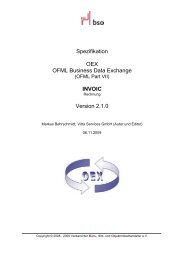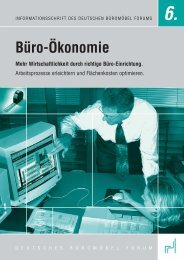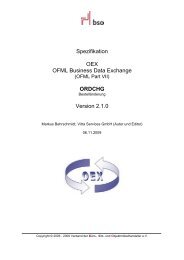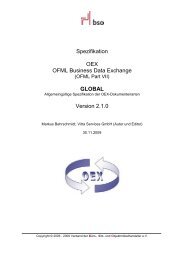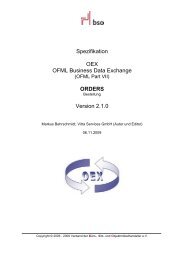New Work Order - Orgatec
New Work Order - Orgatec
New Work Order - Orgatec
- No tags were found...
Create successful ePaper yourself
Turn your PDF publications into a flip-book with our unique Google optimized e-Paper software.
31Offices inTransition<strong>New</strong> <strong>Work</strong> orderWith Organisations beeing Changed by social Networkingthe concpt of an office will also change<strong>New</strong> uses, less space:Nearly 60% of the representativesof majorcompanies surveyedexpect to see futureworking setups to resultin a reduced needfor office space.(Regus 2011)Various interests will influence the way our workplaces are designed in the future. Controllingdepartments will examine locations on the basis of market and manpower volumes.Real estate and facility management divisions will put more cost pressure on facilitiesand adjust space requirements to the mobility needs of employees. This meansoffice spaces and functions will have to be redefined. Internal communication units will try to createmore possibilities for cooperation and informal encounters. Human resources departments willtry to make the workplace more attractive to digital natives and reduce generational conflicts. Corporatestrategy departments will attempt to make company identity a tangible experience internallyand externally in a manner similar to the approach used with flagship stores. This means officeswill need to offer more aesthetic and functional incentives that promote communication andconcentration. That’s because networked employees will be able to select their workplaces flexiblyto ensure that they correspond to their personal needs and those of their teams.Resources and spaces are increasingly underpressure to adaptSabine Heiss, Real Estate Portfolio Manager Central & Eastern Europe at Microsoft, must managespaces and equipment in various branch offices in a way that is profitable and ensures employee satisfaction.A transparent relationship between revenue development and space requirements shouldensure fairness, ambition and comparability. <strong>Work</strong>place design at Microsoft is not about rank, positionor title; the only important things are the job function and the mobility level and communicationrequirements that result from it, as well as revenue development at the branch office inquestion. An interesting aspect here is that Microsoft is redefining the nature of representative officesthrough this approach. Whereas office size used to be a status symbol that reflected the employee’sposition in the hierarchy, Microsoft now allocates office size on the basis of performance.Other companies are completely doing away with status as a consideration in workplace design andinstead employing a system of open-plan offices for everyone. Whereas every employee at Googlehas his or her own desk, Credit Suisse now has a “clean desk” policy at its new facility in southernZurich. As the manager of around 80 buildings in the Zurich region alone, the bank’s Real Estatedivision intended to enable new facilities to be used more flexibly in the future.Non-territoriality does, however, harbour a great risk of alienation. Compensating for thisrisk not only generates additional costs for office space design but also requires extensive measuresfor forming new teams. In German culture, personal occupancy of a location is an important symbolof identification, even if it only represents one’s immediate microcosm. Moreover, those whoNon-territorial formsof work are a minortiyIn 5.6% of companieswith at least ten employeesis an averageof 30% of the workforcenon-territorial.(bso 2012)Desk sharing is theexceptionAn average of only 1.2%of the workforce incompanies with morethan ten employeeshave no workstationspecifically assigned tothem. (ibid.)Germanperception: TheGerman wordArbeitsplatz caneither mean ajob or a physicalworkstation.Other languagesdistinguish betweenthe activityand theterritory.We have a principle in place that says revenue drives headcount and headcountdrives space. The work environment will be evaluated purely on the basis of therequirements associated with employee functions (not positions), and in line with business objectives.Locations where more revenue is generated will be given more workers and the space for accommodatingthem—at least to the extent that the workers’ mobility requires it. For example, a consultant has a mobilitylevel of 1:5, which means that each one has to share his or her workstation with five other consultants.A general manager has a mobility degree of 1:2.Sabine G. Heiss, Real Estate Portfolio Manager Central & Eastern Europe, Microsoft Deutschland





